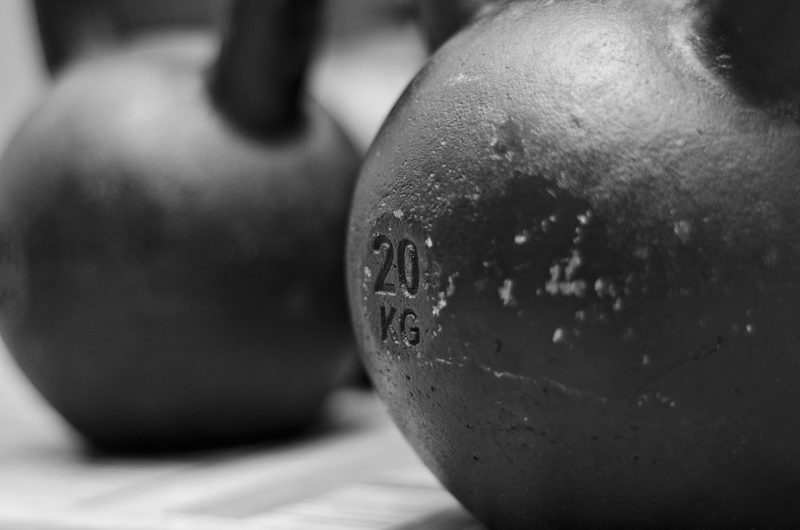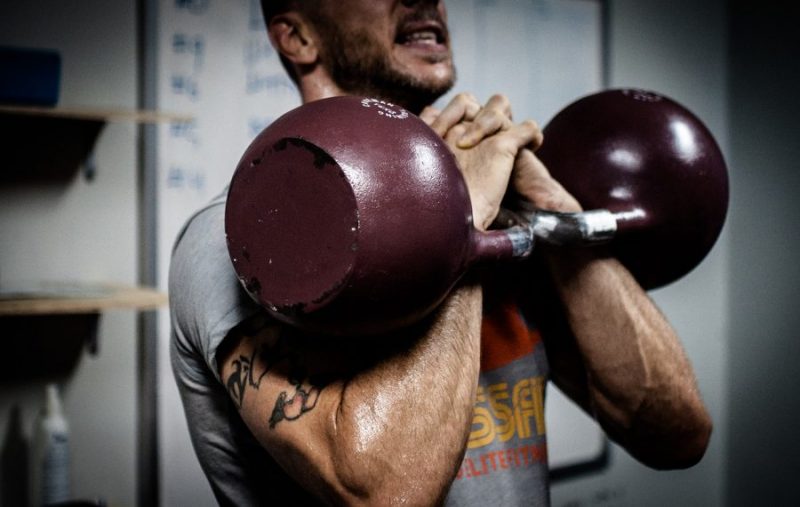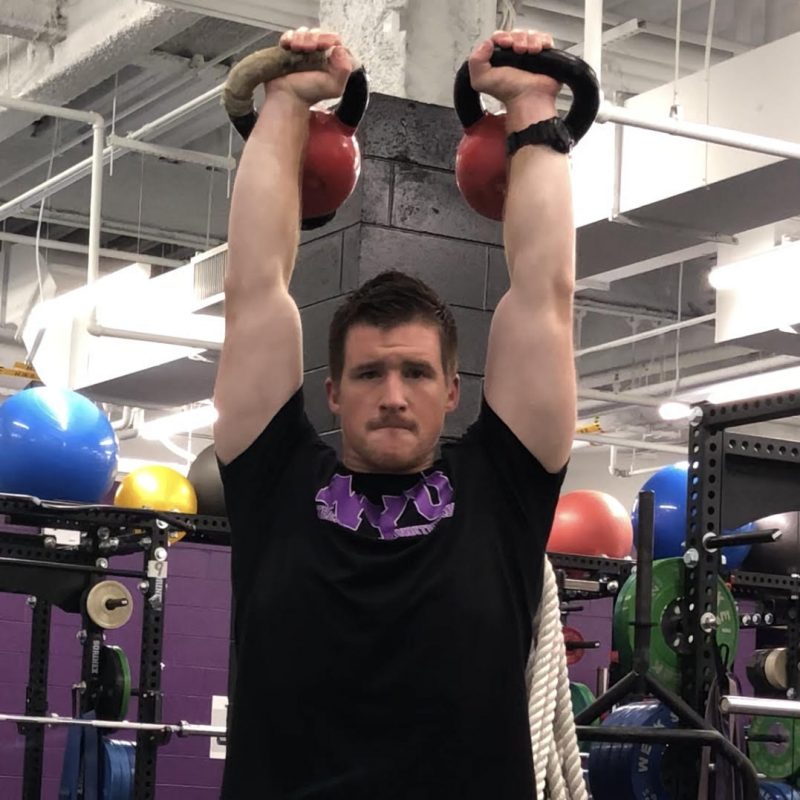There are more awesome things about kettlebells than I can list in the fifteen minutes it will take for a lifter to perform this low impact, high intensity interval training circuit. Suffice it to say, for now, that whether your goals are building strength, increasing endurance, changing your body composition, or just plain feeling like a badass, kettlebells have got you covered. And so does this workout.
The Movements
First, let’s do a quick rundown of the movements you’ll use. For all athletic movements — but perhaps especially for kettlebell moves — it’s essential to ensure that your form is locked in. If possible, seek advice and feedback from someone who has a certification before diving into heavier weights. Always remember to breathe during movements: that one’s pretty important.
Two-handed Single Kettlebell Swing
It’s going to be tempting, both for these swings and the alternating swings, to keep your elbows stiff. But, it’ll be safer for your musculature to keep your elbows soft (not bent, but not locked, either). You also want to ensure that your grip on the kettlebell is stable, but loose at the same time — gripping the bell too hard will interfere with proper movement mechanics.
Alternating Hand Kettlebell Swing
This is one that makes many people nervous because there will, indeed, be a split second where you are not holding the bell; it will be suspended in the air for a moment as you transfer hands. To ensure your comfort when first learning this movement, get confident with single arm swings (all your reps/timing with first one arm, then reset, then repeat with the other arm). Then you can experiment with in-air transfers.
[We think the single arm kettlebell swing is one of the 10 kettlebell exercises every athlete should master.]
Single Arm Kettlebell Clean
This is really a movement where you will know it when you feel it; it will feel, pardon the pun… clean. The bell shouldn’t be slamming on your forearm; if it is, make sure you’re not gripping the bell in the center (you want your grip close to the thumb side), starting with your thumb facing behind you, and keeping the bell path steady as you come up your body. Make sure you’re taking a deep breath before the pull, too, and remember that the power is mostly from your hips, not your arm.
Double Kettlebell Squat and Press
When you press up at the end of this movement, make sure that you are not letting the kettlebells lock out in front of your body; for lifts like this, you want to ensure that the weight is directly above your midfoot, so that your entire skeleton is supporting the weight. Think about it this way: would you rather hold a kettlebell close to your chest (directly above your midfoot) for a full minute, or out with your arms extended in front of you (away from your midfoot, with no skeletal support underneath the weight)? Toss the bells slightly backwards so that they’re above your head rather than in front of it.
Kettlebell Upright Row
It’s all in the wrists, it’s true: you’ll see a lot of people finishing the movement with an extra pull that brings their wrists above their chin, bending to get an extra inch or two of height out of the pull. Those extra couple of inches will, over time, wreak havoc on your wrists: lead the movement with your elbows and treat your wrists as levers rather than a source of extra pull. That way, your musculature, rather than your twisting your body in painful ways, will be leading the movement.
[Want to take your home workouts up a notch — and then several more notches? Check out our ultimate guide to the best kettlebells and grab your own bell!]
The Workout
I designed this workout as something that’s relatively low impact to bring the most benefit to lifters who, like me, have difficulty high impact work because of old injuries, plantar fasciitis, or other issues. Of course, if that describes you, make absolutely certain you check with your physician before embarking on any new workout programs.
This workout can also be used to gas out a lifter who is searching for a finisher at the end of a session, or by anyone looking to get in and get out of the gym as quickly as possible with maximum effectiveness. Especially if you’re an advanced lifter, feel free to use this template to diversify your routine and always modify the workout to fit your body and goals if you need to.
Round 1 (9 minutes)
We’re warming ourselves into the circuit with swings here. Make sure to start the movement with a hinge, by positioning the bell a foot or two in front of you and dragging it back to generate momentum. This drag will protect your low back from any sudden tugging you might otherwise use to start the movement. Set your timer, and have a good time.
- Two-handed Single Kettlebell Swing – 30 seconds. Use a bell that’s just under your 15-rep max. It might feel simple at first, but the limited rest time between sets will ensure that by the end of the round, the weight is anything but easy.
- Alternating Hand Kettlebell Swing – 30 seconds. Again, use a bell that’s about your 15-rep max. Be sure to keep your lower back set and avoid hyperextending to force the bell up. Pro tip: try to keep the bottom of the bell above your knees rather than swinging close to the ground. (Do this with your two-handed swings, too.) This close-to-the-crotch approach will protect your low back much more effectively, and proper form will ensure stronger, more powerful hips.
- Single Arm Kettlebell Clean – 15 seconds each arm. If you’re unfamiliar with this movement especially, make sure you’re reading up on how it’s done: your forearms will regret it if you don’t. Grip the bell snug off to the side rather than in the center, so that the curve of the bell is resting in the pad between your thumb and index finger. To start, rotate the bell so your thumb is pointing behind you when you grasp it. Keep your arm tight into your ribcage as you explode up; this will help ensure that the bell doesn’t (painfully) flop down onto your forearm to get into rack position.
- Rest for 30 seconds.
- Repeat circuit four times.
- Rest one minute to end the round.
Round 2 (6 minutes)
By now, we’ve got a bit of a sweat going. We’ve used power to get us through the first round: now we’re going to make sure you can make it through slower grinds, too. Really gassing your muscles at the end here will keep you straining, but in the pump, positive kind of way.
- Double Kettlebell Squat and Press – 30 seconds. Select your weight judging by your press strength, not your squat strength. Trust me on this one. Choose a weight that you can comfortably press for 12 reps, remembering that press dynamics are slightly different with kettlebells than with dumbbells. Motorcycle your hands forward while gripping the kettlebell, with the same offset grip you use with cleans, so that your wrists aren’t tugged backwards out of neutral by the weight.
- Kettlebell Upright Row – 30 seconds. Select a weight that’s about your 15 rep max. Make sure that you’re leading the motion with your traps: imagine that there are strings attached to the ceiling pulling your elbows toward your chin, and avoid tugging up with the wrists. Again, you want your wrists in relative neutral the entire way through.
- Rest for 30 seconds.
- Repeat circuit four times.
Get Swinging!
This workout will get you pumped up to take on the world — after you cool down and stretch, of course. So, what are you waiting for? Get swinging.
Editor’s note: The content on BarBend is meant to be informative in nature, but it should not be taken as medical advice. The opinions and articles on this site are not intended for use as diagnosis, prevention, and/or treatment of health problems.


